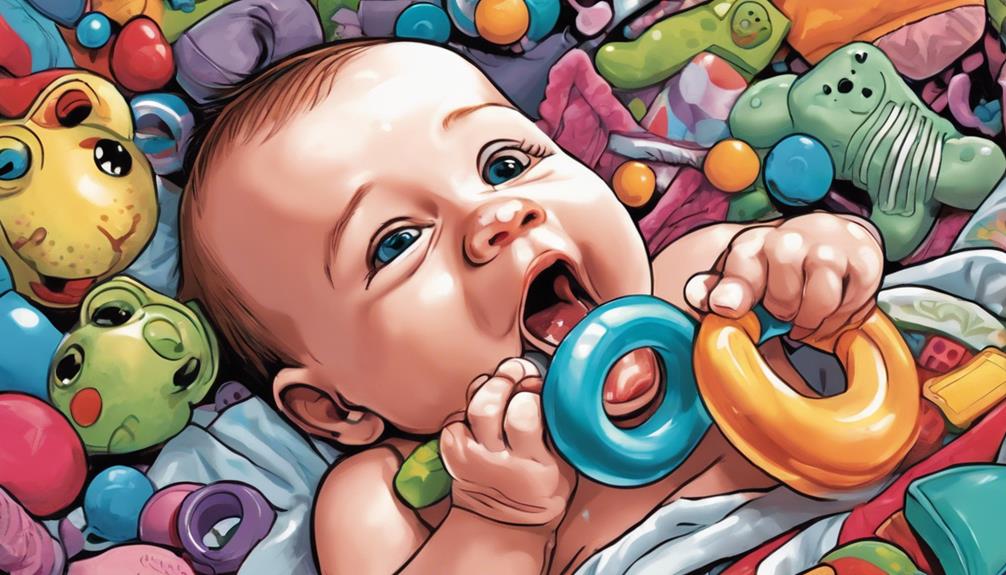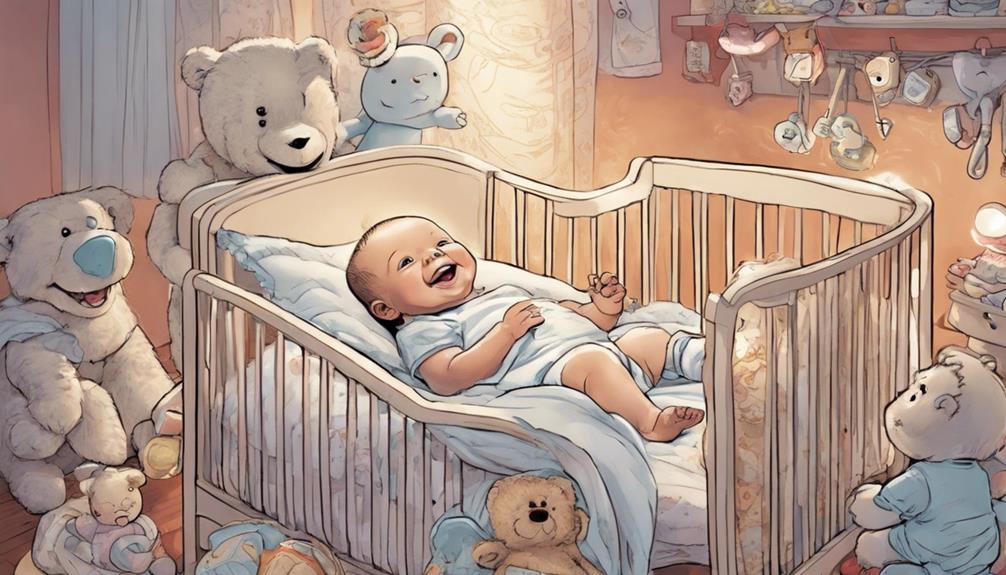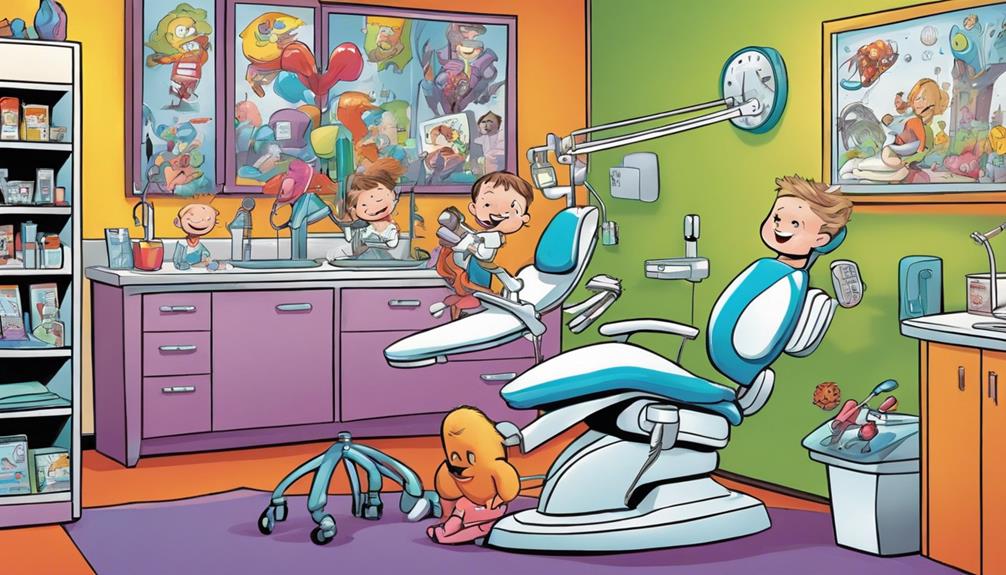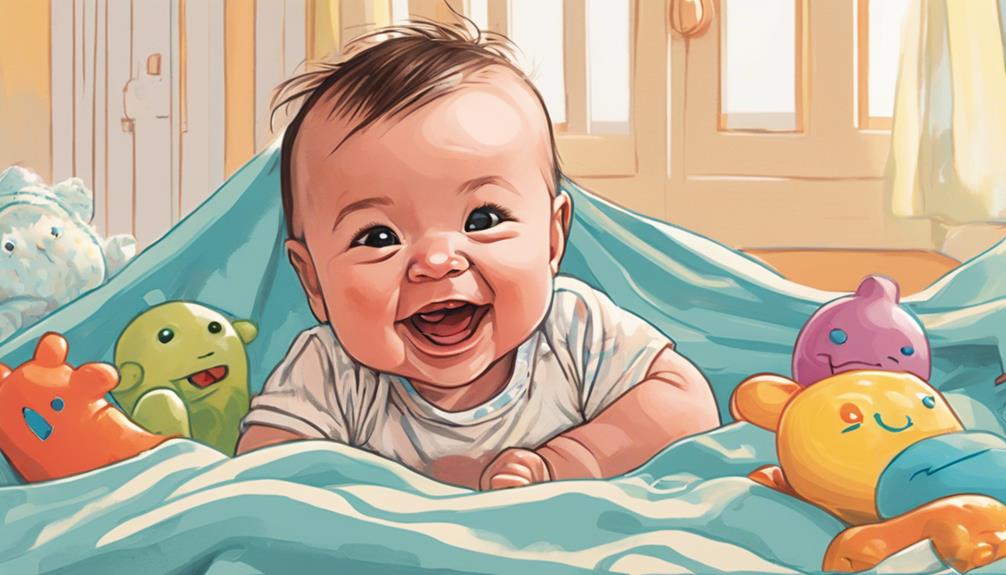Most babies start getting their first teeth between 4 to 7 months old, with some beginning as early as 3 months or even as late as 12 months. Typically, the lower central incisors appear first, followed by the upper front teeth a few weeks later. You'll notice signs like increased drooling and fussiness during this time. It's important to care for their gums even before teeth appear. Understanding the teething process can help you support your baby's comfort during this stage, and there's much more to discover about helping them through it.
Key Takeaways
- Teething typically begins between 4 to 7 months, with most babies starting around 6 months.
- Lower central incisors are usually the first teeth to emerge, appearing between 5 to 7 months.
- Upper central incisors typically follow, erupting between 6 to 10 months.
- Some infants may start teething as early as 3 months or as late as 12 months.
What Is Teething?

Teething is when a baby's primary teeth begin to push through their gums, usually starting between 4 to 7 months of age. The first baby teeth you're likely to notice are the lower central incisors, which typically emerge first. Following these, the upper front teeth usually appear about 4 to 8 weeks later. However, every baby's teething process is unique; some infants may start teething as early as 3 months, while others might not see any teeth until their first birthday.
During this time, your baby may exhibit various symptoms of teething, such as increased drooling, gum irritation, and fussiness. These signs occur as the primary teeth push through the gums, causing discomfort.
It's essential to monitor your baby's oral health during teething, as proper care can help alleviate some of their pain. You might want to offer teething toys or gentle massages to soothe their gums.
Understanding what teething entails can prepare you for this natural yet sometimes challenging phase in your baby's development. Embrace this milestone, as it marks the beginning of your child's journey toward having a healthy set of primary teeth.
When Does Teething Start?

Most babies begin the teething process around 6 months of age, though some might start as early as 3 months. Understanding when your child's teething journey starts can help you prepare for this important milestone.
Here are some key points to reflect upon:
- The first teeth to emerge are usually the lower central incisors, appearing between 5 to 7 months.
- Upper central incisors typically follow 4 to 8 weeks later, usually erupting between 6 to 10 months.
- Some babies mightn't have any teeth by their first birthday, while rare cases exist where infants are born with teeth (natal teeth).
- A full set of 20 primary teeth usually develops by age 3, but there's individual variability in the timing of teething onset.
Knowing when teething starts helps you anticipate your child's needs. Keep in mind that while most babies follow a similar timeline, each child is unique.
Observing your baby closely will help you adapt to their specific teething schedule, ensuring they receive the comfort and care they need during this phase.
Signs of Teething

During the teething phase, you might notice several signs that indicate your baby is experiencing discomfort. Common teething symptoms include increased drooling, which can be quite noticeable. Your little one may also show a strong desire to chew on objects, seeking relief for those sore gums. Swollen gums are another clear sign of teething, as you can often see and feel the tenderness in their mouth.
Irritability is frequently observed during this time; your baby may become fussy and hard to soothe. Additionally, teething pain can disrupt their usual routine. You might find that their sleeping patterns change, with more wake-ups during the night. A decrease in appetite is also common, as eating can become uncomfortable due to gum discomfort.
While slight temperature elevations can occur, keep in mind that a true fever (100.4°F or higher) isn't a normal symptom of teething. By recognizing these signs of teething, you can better understand what your baby is going through and prepare for the challenges that come with this developmental milestone.
Soothing Teething Pain

To help your baby find relief from teething pain, consider a variety of soothing methods that can ease their discomfort. Here are some effective strategies:
- Gum Massage: Gently massage your baby's gums with a clean finger. This immediate touch can provide comfort and relief.
- Chilled Teething Rings: Refrigerate teething rings or wet washcloths. The cold helps soothe sore gums, but steer clear of any items with liquid inside for safety.
- Teething Toys: Offer your baby safe, soft teething toys or dry washcloths to chew on. This can alleviate their teething pain as they gnaw on something comforting.
- Monitor Chewing: If you give your baby teething biscuits, closely watch them to prevent choking hazards.
If your baby's teething pain persists, it's wise to consult a pediatrician. They can suggest appropriate pain relief options tailored for infants, as over-the-counter medications may not be suitable.
Caring for Baby's Teeth

Caring for your baby's teeth starts early, so don't wait for their first tooth to appear before you begin cleaning their gums.
You'll want to establish a daily oral hygiene routine and schedule their first dental appointment by their first birthday.
These steps help guarantee your little one's smile stays healthy as they grow.
Daily Oral Hygiene Practices
Start cleaning your baby's gums with a soft cloth or gauze after feedings to help remove bacteria and sugar before their teeth come in. Establishing good oral hygiene early on is key to preventing tooth decay.
Here are some essential daily oral hygiene practices:
- Brush as soon as the first tooth appears: Introduce a soft-bristled toothbrush with a smear of fluoride toothpaste.
- Brush twice a day: Aim for brushing after breakfast and before bedtime to reinforce good habits.
- Monitor brushing technique: Keep an eye on how your child brushes until they're about 7 or 8 to guarantee they're using the right amount of toothpaste and technique.
- Consider teething gels: If your baby seems uncomfortable during teething, teething gels can provide temporary relief, but always consult your pediatrician first.
First Dental Appointment Timing
Scheduling your child's first dental appointment by their first birthday guarantees they're on the right path for healthy teeth and gums. This early visit helps establish a dental home, ensuring your little one receives essential care and advice. Pediatric dentists recommend this timing to monitor dental health, educate you on oral hygiene practices, and discuss dietary habits that support healthy teeth.
Here's a quick overview of what you can expect during this important appointment:
| Aspect | Details |
|---|---|
| Purpose | Assess dental health and educate on hygiene |
| Topics Covered | Teething, fluoride needs, and preventive measures |
| Benefits | Instills positive dental attitudes and reduces anxiety |
| Follow-up Visits | Recommended every six months for ongoing care |
Teething Timeline

Teething usually kicks off between 4 to 7 months, with some babies getting their first tooth as early as 3 months or as late as 12 months. Understanding the teething timeline can help you anticipate when your baby starts teething and what to expect. Here are some key milestones:
- First teeth to come: Typically, the lower central incisors emerge between 5 to 7 months.
- Upper central incisors: These usually follow, appearing around 6 to 8 months, about 4 to 8 weeks after the lower ones.
- Individual variability: Some babies may have their first tooth by 6 months, while others mightn't have any by their first birthday.
- Full set: By age 3, your child should have a complete set of 20 primary teeth.
Importance of Fluoride

As your baby develops their first teeth, understanding the role of fluoride in strengthening enamel and preventing decay becomes increasingly important. Fluoride is essential for reinforcing tooth enamel, which acts as a protective barrier against cavities. Making sure your baby receives adequate fluoride can greatly reduce the risk of dental issues as they grow.
Most tap water in the United States contains added fluoride, making it a key source for your child. Introducing water in a sippy or straw cup around six months can help incorporate fluoride into their diet. However, if you live in an area without fluoridated water, consult your pediatrician about whether your baby needs additional fluoride supplements.
Be cautious with bottled water, as many brands lack fluoride. Always check labels to make certain you're choosing products that support your child's dental health.
Unsafe Teething Products

When it comes to teething products, you need to be cautious about what you choose for your baby.
Some items contain harmful ingredients or pose choking hazards, while others simply don't work.
Always consult your pediatrician and prioritize safety when selecting teething remedies.
Harmful Ingredients to Avoid
Many parents unknowingly choose unsafe teething products that can pose serious risks to their baby's health. To help you navigate this tricky landscape, here are four harmful items to avoid:
- Teething tablets: Many contain belladonna or benzocaine, both linked to severe side effects and warned against by the FDA.
- Amber teething necklaces: These pose choking and strangulation risks. Plus, there's no scientific evidence supporting their effectiveness for teething pain relief.
- 'Natural' teething remedies: Just because a product claims to be natural doesn't mean it's safe. Always check for harmful ingredients on the label.
- Small teething toys: Products that can break into small parts present choking hazards for infants and should be avoided.
Always consult with your pediatrician before using any over-the-counter teething pain relief products. They can guide you on safe options that won't expose your baby to harmful ingredients.
Your baby's safety should always come first, so do your research and choose wisely!
Choking Hazards Considerations
Teething products can present serious choking hazards, so it's crucial to choose items that are safe and specifically designed for infants. Avoid teething necklaces, as they pose risks of strangulation and choking without any proven benefits.
Instead, look for large, solid teething toys that won't break easily. Always check for safety features, confirming there are no small parts that could pose a choking hazard for your baby.
While it's vital to alleviate discomfort during teething, safety should be your top priority. Supervise babies closely while they use teething toys to prevent any accidents. It's easy for infants and children to get overly excited and unknowingly put themselves at risk.
Consult your pediatrician for recommendations on safe teething products that can help ease your baby's pain without introducing unnecessary dangers.
Ineffective Alternative Remedies
Choosing safe teething products is crucial, especially with the prevalence of ineffective alternative remedies that can endanger your baby's health. Here are some unsafe options you should avoid:
- Teething tablets: Many contain belladonna and benzocaine, both deemed unsafe by the FDA due to serious side effects and questionable effectiveness.
- Amber teething necklaces: These pose significant risks, including strangulation and choking, with no scientific backing for their pain-relieving claims.
- Teething gels with benzocaine: The FDA warns against using these for infants under 2 years old, as they can lead to methemoglobinemia, a dangerous condition that reduces blood oxygen levels.
- Small or breakable objects: Avoid giving your baby these as teething aids, as they can create choking hazards during this sensitive time.
When selecting teething remedies, prioritize safety. Many alternative products lack proper regulation, putting your child's well-being at risk.
Stick to recommendations from healthcare professionals to guarantee your baby gets the relief they need without jeopardizing their health.
First Dental Appointment

Scheduling your child's first dental appointment is essential after their first tooth erupts, ideally by their first birthday. This early visit helps establish a dental home, allowing the pediatric dentist to monitor dental health and development as your child grows.
During the initial appointment, the dentist will assess your child's teeth, gums, and overall oral hygiene practices. You'll receive valuable guidance on proper oral care, including effective brushing techniques and dietary recommendations for peak dental health. This foundational knowledge helps you create a routine that encourages good habits from the start.
Moreover, introducing your child to the dental environment at an early age can help reduce anxiety for future appointments. Familiarity with the sights and sounds of the dental office makes it easier for your child to feel comfortable during subsequent visits.
Frequently Asked Questions
At What Age Do Babies Start Showing Teeth?
Babies usually start showing teeth around 4 to 7 months, though it can vary. Some might even show their first tooth as early as 3 months, while others might wait until 12 months.
Is My 3 Month Old Teething?
If your 3-month-old's drooling more and chewing on toys, they might be teething. Look for signs like irritability or gum swelling, but remember, not all babies show discomfort during this stage.
How Long Does It Take for Baby Teeth to Come In?
It usually takes several months for baby teeth to come in, starting around 6 months. You might see the first teeth erupt between 5 to 7 months, with a full set by age 3. This period of tooth eruption is often referred to as the baby teething timeline. During this time, your baby may experience some discomfort and irritability as their teeth push through their gums. You can help alleviate their discomfort by gently massaging their gums with a clean finger or providing them with a teething toy to chew on. Remember that every baby is different, so their teething timeline may vary slightly. The baby teeth development timeline is an important milestone in your child’s growth and development. It’s important to start taking care of your baby’s oral health as soon as their first teeth come in. You can begin by gently brushing their teeth with a soft toothbrush and a tiny smear of fluoride toothpaste. Regular dental check-ups are also important to monitor the progression of their baby teeth development timeline and address any concerns early on. As their baby teeth come in, it’s also a good time to introduce them to healthy eating habits and limit sugary snacks and drinks to promote strong and healthy teeth.
When Do Babies Get Each Tooth?
Your baby typically gets their lower central incisors first, around 5-7 months. Next, the upper central incisors emerge between 6-8 months, followed by lateral incisors at 9-12 months. Each child's timing varies.
Conclusion
Teething can feel like a stormy sea for both you and your baby. Just as sailors navigate through rough waters, you can steer your little one toward comfort with the right soothing techniques.
Remember, teething is a natural process that paves the way for healthy teeth and smiles. By staying informed and proactive, you'll help your baby weather this phase with ease.
Before you know it, those tiny teeth will shine bright, ready for all the giggles ahead!









